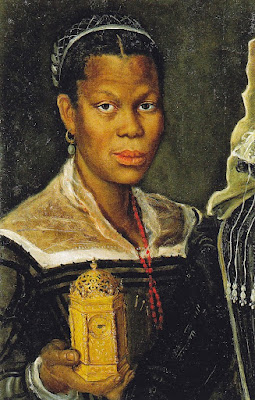Circle of Bartolomeo Passarotti. 1579.
Dominico Giuliani and his Servant.Manchester City Galleries, Manchester.
Dominico Giuliani and his Servant.Manchester City Galleries, Manchester.
There are gorgeous Renaissance portraits in which a black -- smaller proportions, lower-down, looking up -- is shown as the accessory of fashion and power. The black is another possession, along with the mechanical gold clock, the pearls, the gold buttons, and the armor. Look at the Titian portrait of Federico Gonzaga with his hand on his white dog, below, and then at the picture of Princess Juana with her hand on her black boy.
But a few of these portraits seem to present something more complex. What does it mean, in the Bordone portrait of the man in armor, below, that he has one arm around the white page and the other arm separated from the black page by a black helmet shown with more clarity than the page? Is this painting wrongly labeled? Was the man painted with his son -- look at those noses -- first, and then the black boy posed separately? What about the first one here, where the black -- servant -- is shown in equal proportion? This servant has so much the look of Dominico Giuliani, that he could be his son -- is surely his son. I am fascinated that the word "son" came to mind immediately in looking at these two paintings, both new to me.
Paris Bordone. Mid-16th C.
Portrait of a Man in Armor with Two Pages.
Metropolitan Museum of Art.
Portrait of a Man in Armor with Two Pages.
Metropolitan Museum of Art.
Christovao de Morais, 1555.
Juana of Austria, Daughter of Charles V.
Juana of Austria, Daughter of Charles V.
Musées royaux des Beaux-Arts, Brussels.
Titian, 1558.
Portrait of Fabrizio Salvaressa.
Kunsthistorisches Museum, Vienna.
Portrait of Fabrizio Salvaressa.
Kunsthistorisches Museum, Vienna.
Titian, 1573.
Portrait of Laura die Dianti.
Collection Heinz Kisters, Switzerland.
Portrait of Laura die Dianti.
Collection Heinz Kisters, Switzerland.
Individual portraits of blacks in the same years show complex individuals. It is difficult for me to separate my own reaction of sadness from what I read in the faces. I immediately begin to construct a back story for them. My own back story: I grew up in West Africa -- I have been in the ports, up the rivers, know the scents and sounds from which these people were taken.
. Jan Jansz Mostaert, ca. 1520-25.
Portrait of a Black Man.
Rijksmuseum, Amsterdam.
Portrait of a Black Man.
Rijksmuseum, Amsterdam.
Annibale Carracci, ca. 1580s. Portrait of an African Slave Woman.
Tomasso Brothers, Leeds. England.
Tomasso Brothers, Leeds. England.
Flemish/German. 1530-40.
Portrait of a Wealthy African.
Private Collection, Antwerp.
Portrait of a Wealthy African.
Private Collection, Antwerp.
Workshop of Gerard David. ca. 1514.
Detail, Adoration of the Kings.
Princeton University Art Museum.
Rafaello Schiamiossi (?). ca. 1608.
Don Antonio Manuele de Funta,
Ambassador of the King of the Kongo to the Pope.
Don Antonio Manuele de Funta,
Ambassador of the King of the Kongo to the Pope.
Baltimore Museum of Art.











An interesting and diverse collection of images of the black during the period. I can understand when you write about the difficultly you have separating your reaction of sadness from what you read in the faces.
ReplyDeleteThanks for sharing.
Thank you for taking the time to comment.
ReplyDeleteThat last painting is mislabeled. It's by Domenico Tintoretto c. 1600 and is housed in the Morgan Library.
ReplyDelete